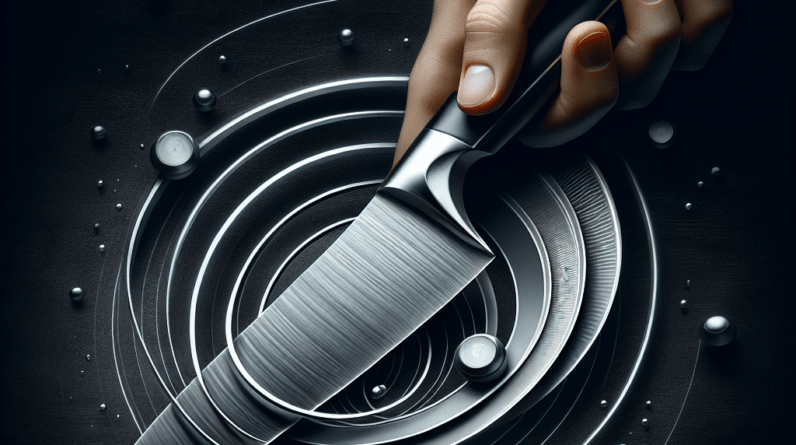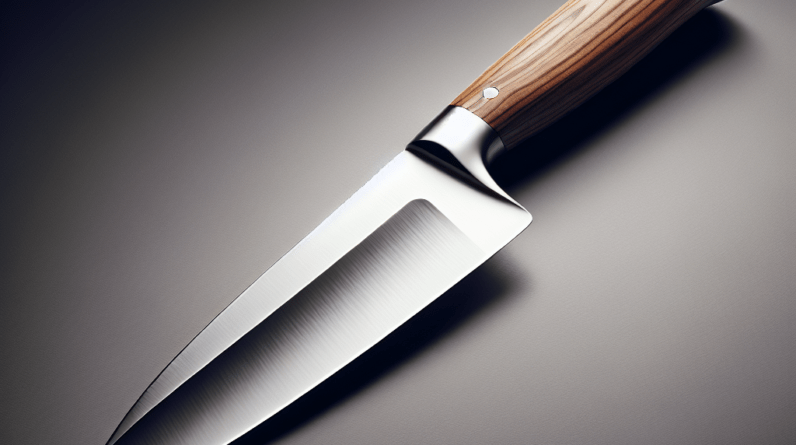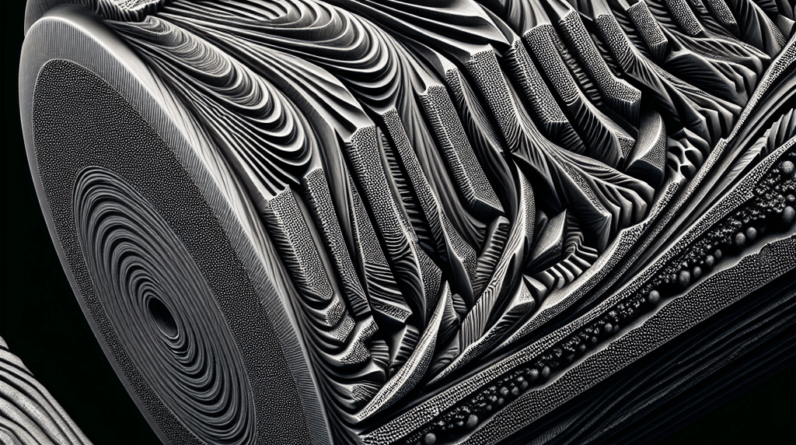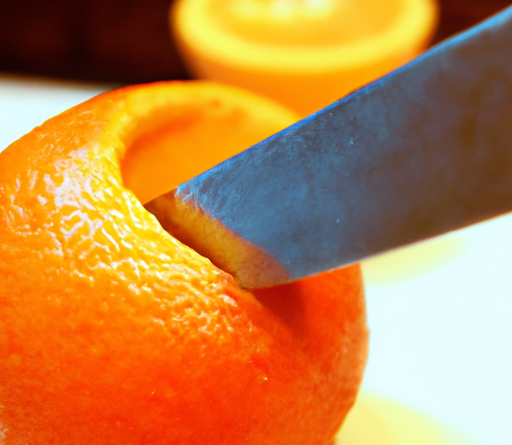In this article, we will explore the various handle materials commonly used for kitchen knives. When it comes to choosing the perfect kitchen knife, the handle material is just as important as the blade itself. After all, the handle is what provides us with a comfortable grip and allows us to maneuver the knife with ease. From durable and ergonomic options like wood and synthetic materials to more luxurious choices such as bone and horn, we will dive into the world of handle materials and help you make an informed decision for your culinary adventures.
Wood
Hardwood
One common type of handle material for kitchen knives is hardwood. Hardwood handles are known for their durability and natural beauty. They are made from the wood of deciduous trees such as oak, maple, walnut, and cherry. Hardwood handles are often favored for their excellent grip and warm feel in the hand. They are carefully sanded and finished to bring out the unique grain patterns and enhance their visual appeal. Hardwood handles may require periodic maintenance, such as oiling, to keep them looking their best and to prevent them from drying out.
Softwood
Another type of handle material commonly used for kitchen knives is softwood. Softwood handles are made from the wood of coniferous trees, including pine, spruce, and fir. These handles offer a lightweight and comfortable grip, making them popular among users who prefer a less hefty knife. Softwood handles are characterized by their pale color and straight grain patterns. While they may not be as durable as hardwood handles, they are still capable of providing reliable performance in the kitchen. However, due to their tendency to absorb moisture, they require extra care to prevent warping and splitting.
Laminated Wood
Laminated wood handles combine the best qualities of hardwood and softwood handles. They are made by layering thin sheets of wood together and bonding them under high pressure and temperature. This process creates a handle that is strong, stable, and resistant to moisture. Laminated wood handles are visually appealing, as different types of wood can be used to create striking patterns and colors. With their excellent durability and comfortable grip, laminated wood handles are a popular choice among knife enthusiasts and professional chefs alike.
Plastic
Polypropylene
Polypropylene is a versatile and widely used material for knife handles. It is a thermoplastic polymer known for its light weight, durability, and resistance to chemicals. Polypropylene handles are easy to clean and maintain, making them a practical choice for busy kitchens. They are often molded with textured or ribbed patterns to provide a secure grip and prevent slippage. While not as visually appealing as natural materials, polypropylene handles offer excellent functionality at an affordable price point.
POM
POM, or polyoxymethylene, is a high-performance engineering plastic commonly used in knife handles. It is known for its exceptional strength, stiffness, and dimensional stability. POM handles have a smooth and polished appearance, offering both visual appeal and a comfortable grip. They are resistant to chemicals, heat, and moisture, making them suitable for heavy kitchen use. POM handles are often preferred by professional chefs and culinary enthusiasts who value durability and precision in their knives.
Nylon
Nylon handles are lightweight, flexible, and affordable. They are made from a synthetic polymer known for its low friction properties and resistance to abrasion. Nylon handles are often textured or molded with gripping patterns to provide a secure and non-slip grip. They are particularly popular in outdoor and survival knives due to their resistance to extreme temperatures and harsh environments. Nylon handles are easy to clean and maintain, making them a practical choice for everyday kitchen tasks.
Fiberglass
Fiberglass is a composite material made of fine glass fibers embedded in a resin matrix. It is known for its exceptional strength, rigidity, and resistance to impact. Fiberglass handles offer a high level of durability, making them suitable for heavy-duty kitchen use. They are often reinforced with additional layers of fiberglass for added strength and stability. Fiberglass handles can be textured or molded into ergonomic shapes to provide a comfortable and secure grip. While not as visually appealing as natural materials, fiberglass handles excel in terms of performance and longevity.
Stainless Steel
Full Stainless Steel Handle
A full stainless steel handle is a solid piece of stainless steel that serves as both the handle and the bolster of the knife. It offers a sleek and modern appearance, making it a popular choice for contemporary kitchen knives. Full stainless steel handles are highly durable, resistant to corrosion, and easy to clean. They provide a balanced weight distribution and a sturdy grip, making them suitable for precise cutting tasks. While they may lack the warmth and natural feel of other handle materials, full stainless steel handles are favored by users who prioritize durability and ease of maintenance.
Stainless Steel Riveted Handle
Stainless steel riveted handles consist of a stainless steel frame that is riveted to the tang of the knife. This construction allows for a combination of stainless steel and other materials, such as wood, plastic, or composite. Stainless steel riveted handles offer the best of both worlds – the strength and durability of stainless steel, combined with the aesthetic appeal and comfort of other handle materials. The rivets not only provide a secure attachment but also add visual interest to the handle. With their stylish appearance and reliable performance, stainless steel riveted handles are a popular choice among professional chefs and kitchen enthusiasts.
Composite
G-10
G-10 is a high-pressure fiberglass laminate known for its strength, durability, and resistance to moisture and chemicals. It is made by layering fiberglass fabric with epoxy resin and compressing it under high pressure and temperature. G-10 handles offer a solid and secure grip, even in wet conditions. They are highly resistant to impact, making them suitable for heavy kitchen use. G-10 handles are available in a variety of colors and textures, allowing for customization and personalization.
Micarta
Micarta is another type of composite material commonly used for knife handles. It is made by layering fabrics, such as linen or paper, with epoxy resin and compressing them under high pressure and heat. Micarta handles are known for their excellent grip, durability, and resistance to moisture and chemicals. They can be smooth or textured, providing a comfortable and secure hold. Micarta handles are available in a range of colors and patterns, making each knife unique and visually appealing.
Fiberglass Reinforced Polymer
Fiberglass reinforced polymer (FRP) handles are made by infusing fiberglass strands with a polymer resin. This process creates a lightweight yet sturdy handle that is highly resistant to impact, heat, and chemicals. FRP handles offer a comfortable grip and excellent durability, making them suitable for heavy-duty kitchen tasks. They are available in a variety of colors and textures, allowing for customization and personalization. With their combination of strength, functionality, and aesthetics, fiberglass reinforced polymer handles are a popular choice for kitchen knives.
Rubber
Thermoplastic Elastomer (TPE)
Thermoplastic elastomer (TPE) handles are made from a blend of rubber and plastic. They offer a soft and comfortable grip, allowing for extended use without hand fatigue. TPE handles have a non-slip surface, even when wet, providing excellent control and precision. They are resistant to chemicals, heat, and impact, making them suitable for demanding kitchen environments. TPE handles are available in a range of colors and can be textured or molded into ergonomic shapes for enhanced comfort and grip.
Krayton
Krayton is a synthetic rubber material known for its excellent durability and resistance to abrasion. Krayton handles offer a soft and cushioned grip, reducing hand fatigue during prolonged use. They have a tacky surface that provides a secure hold, even in wet conditions. Krayton handles are highly resistant to chemicals, oil, and heat, making them suitable for heavy kitchen use. They are available in various colors and textures, allowing for customization and personalization.
Kraton
Kraton is a synthetic rubber material known for its superior grip and shock-absorbing properties. Kraton handles offer a comfortable and secure hold, even in wet or greasy conditions. They are highly resistant to abrasion, chemicals, and heat, making them suitable for demanding kitchen environments. Kraton handles can be textured or molded into ergonomic shapes, providing optimal comfort and control. With their combination of durability, functionality, and grip, Kraton handles are a popular choice for professional chefs and home cooks alike.
Santoprene
Santoprene is a thermoplastic elastomer known for its excellent grip, resilience, and resistance to heat and chemicals. Santoprene handles offer a comfortable and non-slip grip, making them ideal for kitchen knives. They have a soft yet durable texture, providing optimal control and reducing hand fatigue. Santoprene handles are available in various colors and can be textured or molded into ergonomic shapes for enhanced comfort and grip. With their reliable performance and ergonomic design, Santoprene handles are a popular choice among professional chefs and cooking enthusiasts.
Bone
Genuine Bone
Genuine bone handles offer a unique and natural aesthetic, as no two bones are alike. They are made from the bones of animals, such as cattle or deer, which undergo a thorough cleaning and preparation process. Genuine bone handles have a smooth and polished surface that provides a comfortable grip. They can be dyed or adorned with decorative patterns to enhance their visual appeal. Bone handles require occasional oiling to prevent drying and keep them looking their best. With their timeless beauty and individual character, genuine bone handles add a touch of elegance to any kitchen knife.
Stag Horn
Stag horn handles are made from the antlers of deer or other similar animals. They are characterized by their rugged and natural appearance, featuring a textured surface with ridges and bumps. Stag horn handles offer an excellent grip, even in wet or greasy conditions. They provide a unique and rustic aesthetic that appeals to outdoor enthusiasts and individuals who appreciate traditional craftsmanship. Stag horn handles require occasional maintenance, such as oiling, to preserve their natural luster. With their distinctive beauty and tactile feel, stag horn handles make a statement in any kitchen.
Horn
Buffalo Horn
Buffalo horn handles are made from the horns of domesticated water buffalo. They are known for their durability, strength, and unique patterns. Buffalo horn handles offer a smooth and polished surface that provides a comfortable grip. They can be dyed or buffed to enhance their natural colors and textures. Buffalo horn handles require regular maintenance to prevent drying and cracking, but with proper care, they can last a lifetime. With their elegant appearance and tactile feel, buffalo horn handles bring a touch of sophistication to kitchen knives.
Ox Horn
Ox horn handles are made from the horns of oxen and have a similar appearance to buffalo horn handles. They offer a smooth and polished surface with natural variations in color and pattern. Ox horn handles provide a comfortable grip and add a touch of elegance to kitchen knives. They require regular maintenance to prevent drying and cracking, as well as occasional polishing to maintain their luster. Ox horn handles are favored by individuals who appreciate the beauty of natural materials and seek a unique and distinctive handle for their knives.
Genuine Horn
Genuine horn handles are made from various animal horns, including buffalo, ox, or sheep. They offer a unique and organic beauty, with each handle possessing its own distinct color, grain pattern, and texture. Genuine horn handles provide a comfortable grip, featuring a smooth and polished surface. They require regular maintenance, such as oiling, to prevent drying and cracking. With their natural elegance and individual character, genuine horn handles add a touch of luxury to kitchen knives.
Resin
Epoxy Resin
Epoxy resin handles are made by mixing epoxy resin with a hardener and allowing it to cure. They offer a durable and visually striking appearance. Epoxy resin handles can be custom-made to feature various colors, patterns, and even embedded objects such as flowers or glitter. They offer a smooth and glossy surface that is comfortable to hold. Epoxy resin handles require minimal maintenance, with occasional cleaning to preserve their shine. With their unique customization options and modern aesthetics, epoxy resin handles add a creative flair to kitchen knives.
Acrylic Resin
Acrylic resin handles are made by mixing acrylic resin with a hardener and curing it under controlled conditions. They offer a smooth, polished surface that is visually appealing and comfortable to grip. Acrylic resin handles can be customized to feature various colors and patterns, including translucent and pearlescent effects. They require minimal maintenance, with occasional cleaning to maintain their shine. Acrylic resin handles are favored for their durability, versatility, and ability to add a pop of color to kitchen knives.
Metal
Aluminum
Aluminum handles offer a lightweight and sleek design. They are known for their excellent durability, corrosion resistance, and ease of maintenance. Aluminum handles can be anodized to provide additional protection and enhance their appearance. They offer a comfortable grip and are favored by individuals who prefer a lighter knife. Aluminum handles are available in various finishes and colors, making them a versatile choice for kitchen knives.
Brass
Brass handles offer a classic and elegant appearance. They are made from an alloy of copper and zinc, known for its durability and corrosion resistance. Brass handles develop a natural patina over time, adding to their visual appeal. They offer a comfortable grip and a balanced weight. Brass handles require occasional polishing to maintain their shine. With their timeless beauty and warm tones, brass handles provide a touch of sophistication to kitchen knives.
Copper
Copper handles offer a distinctive and rich aesthetic. They are made from pure copper and known for their excellent heat conductivity and corrosion resistance. Copper handles develop a unique patina over time, giving them a rustic and vintage look. They offer a comfortable grip and a luxurious weight. Copper handles require periodic cleaning to maintain their luster. With their warm tones and antique charm, copper handles make a statement in any kitchen.
Titanium
Titanium handles offer a lightweight and modern design. They are made from a strong and corrosion-resistant metal known for its high strength-to-weight ratio. Titanium handles are known for their durability, toughness, and resistance to wear and tear. They offer a comfortable grip and excellent balance. Titanium handles are available in various finishes, including brushed or anodized, providing a sleek and contemporary appearance. With their exceptional strength and sleek aesthetics, titanium handles are a popular choice among knife enthusiasts and professional chefs.
Leather
Rawhide
Rawhide handles are made from animal hides that have been processed through a specialized method known as tanning. They offer a rustic and natural appearance, featuring a textured surface and varying shades of color. Rawhide handles offer a comfortable and non-slip grip, even in wet conditions. They require regular maintenance, such as oiling, to prevent drying and cracking. Rawhide handles add a unique touch of authenticity and craftsmanship to kitchen knives.
Genuine Leather
Genuine leather handles are made from high-quality animal hides that have been tanned and treated to ensure durability and optimal performance. They offer a timeless and sophisticated appearance, featuring a smooth and supple surface. Genuine leather handles provide a comfortable grip, molding to the shape of the hand over time. They require regular maintenance, such as conditioning, to maintain their softness and prevent drying. With their luxurious feel and classic elegance, genuine leather handles elevate the aesthetics of kitchen knives.
Synthetic Leather
Synthetic leather handles mimic the look and feel of genuine leather but are made from artificial materials. They offer a similar texture and appearance, providing a comfortable and secure grip. Synthetic leather handles are often more affordable and require less maintenance compared to genuine leather handles. They are resistant to moisture and easy to clean, making them suitable for everyday kitchen use. Synthetic leather handles offer a versatile and cost-effective alternative for individuals who value the aesthetics of leather but prefer a more practical handle material.
In conclusion, the choice of handle material for a kitchen knife depends on personal preference and intended use. Each material offers its own unique combination of aesthetics, durability, comfort, and functionality. Whether you prioritize elegance, durability, grip, or ease of maintenance, there is a handle material that will suit your needs. From the timeless beauty of wood and bone to the modern functionality of plastic and metal, the right handle material can enhance your kitchen experience and make food preparation a joyous task.










